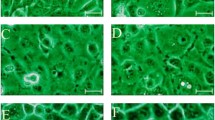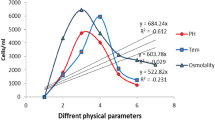Abstract
In this work we describe the adaptation of channel catfish ovary (CCO) cell line to commercially available Ultra Culture serum-free medium by gradual reduction of serum concentration from 10 to 0 %. With this approach we obtained CCO cells fully adapted to serum-free conditions in 32 days. Growth, nutritional and morphological characteristics of these cells remained unchanged when compared to the control group kept in the presence of serum. Additionally, three commercially available protein hydrolysates were tested for the effects on growth performance of the newly serum-free adapted CCO cells. Supplementation with wheat gluten hydrolysate resulted in growth similar to serum free medium solely, while yeast and soy hydrolysates showed inhibitory effects on the cell growth. Taken together, the successful adaptation of CCO cells to serum-free conditions indicates their potential to be used in cytotoxicity assays when serum omission is demanded or for developing serum free bioprocesses using CCO cells. However, a more extended study on nutrient supplementation is still required to further boost the cell growth in a serum free culture.




Similar content being viewed by others
References
Ackermann G, Fent K (1998) The adaptation of the permanent fish cell lines PLHC-1 and RTG-2 to FCS-free media results in similar growth rates compared to FCS-containing conditions. Mar Environ Res 46:363–367
Bols N, Dayeh VR, Lee LEJ, Schirmer K (2005) Use of fish cell lines in the toxicology and ecotoxicologyof fish. Piscine cell lines in environmental toxicology. In: Mommsen TP, Moon TW (eds) Biochemistry and molecular biology of fishes, vol. 6. Environmental Toxicology, Elsevier BV, pp 43–84
Brunner D, Frank J, Appl H, Schöffl H, Pfaller W, Gstraunthalter G (2010) Serum-free cell culture: the serum-free media interactive online database. ALTEX 27:1–10
Castaño A, Gómez-Lechón MJ (2005) Comparison of basal cytotoxicity data between mammalian and fish cell lines: a literature survey. Toxicol In Vitro 19:695–705
Castaño A, Bols N, Braunbeck T, Dierickx P, Halder M, Isomaa B, Kawahara, Lee LK, Mothersill C, Pärt P, Repetto G, Riego Sintes J, Rufli H, Smith R, Wood C, Segner H (2003) The use of fish cells in ecotoxicology: the report and recommendations of ECVAM Workshop 47. ATLA 31:317–351
Chun BH, Kim JH, Lee HJ, Chung NH (2007) Usability of size-excluded fractions of soy protein hydrolysates for growth and viability of Chinese hamster ovary cells in protein-free suspension culture. Bioresour Technol 98:1000–1005
Cruz PE, Moreira JL, Carrondo MJT (1997) Insect cell growth evaluation during serum-free adaptation in stirred suspension cultures. Biotechnol Tech 11:117–120
El Enshasy H, Abdeen A, Abdeen S, Elsayed EA, EL Demellawy M, EL Shereef AA (2009) Serum concentration effects on the kinetics and metabolism of HeLa-S3 cell growth and cell adaptability for successful proliferation in serum free medium. World Appl Sci J 6:608–615
Fargess-Haddani B, Tessier B, Chenu S, Chevalot I, Harscoat C, Marc I, Goerge JL, Marc A (2006) Peptide fractions of rapeseed hydrolysates as an alternative to animal proteins in CHO cell culture media. Proc Biochem 41:2297–2304
Franěk F, Katinger H (2002) Specific effects of synthetic oligopeptides on cultured animal cells. Biotechnol Prog 18:155–158
Franěk F, Hohenwarter O, Katinger H (2000) Plant protein hydrolysates: preparation of defined peptide fractions promoting growth and production in animal cells cultures. Biotech Prog 16:688–692
Freshney RI (2005) Culture of animal cells: a manual of basic technique, 5th edn. Wiley, New Jersey
Girón-Cale J, Vioque J, Pedroche J, Alaiz M, Yust MM, Megías C, Millán F (2008) Chickpea protein hydrolysate as a substitute for serum in cell culture. Cytotechnology 57:263–272
Keenan J, Pearson D, Clynes M (2006) The role of recombinant proteins in the development of serum-free media. Cytotechnology 50:49–56
Kim S, Lee G (2009) Development of serum-free medium supplemented with hydrolysates for the production of therapeutic antibodies in CHO cell cultures using design of experiments. Appl Microbiol Biotechnol 83:639–648
Kohlpoth M, Rusche M (1997) Cultivation of permanent fish cell line in serum-free media: special experiences with a cytotoxicity test for waste water samples. ALTEX 14:16–20
Lakra WS, Swaminathan TR, Joy KP (2011) Development, characterization, conservation and storage of fish cell lines: a review. Fish Physiol Biochem 37:1–20
McDowell CL, Paputsakis ET (1998) Serum increasec the CD13 receptor expression, reduces the transduction of fluid-mechanical forces and alters the metabolism of HL60 cells cultured in agitated bioreactors. Biotechnol Bioeng 60:259–268
Merten OW (2006) Introduction to animal cell culture technology: past, present and future. Cytotechnology 50:1–7
Ozturk SS, Palsson BO (1991) Physiological changes during the adaptation of hybridoma cells to low serum and serum-free media. Biotechnol Bioeng 37:35–46
Schirmer K (2006) Proposal to improve vertebrate cell cultures to establish them as substitutes for the regulatory testing of chemicals and effluents using fish. Toxicology 224:163–183
Shea TB, Berry ES (1983) A serum-free medium that supports the growth of piscine cell cultures. In Vitro 19:818–824
Shen AY, Van de Goor J, Zheng L, Reyes AE, Krummen LA (2006) Recombinant DNA technology and cell line development. In: Ozturk SS, Hu W-S (eds) Cell culture technology for pharmaceutical and cell-based therapies. CRC Press, Taylor and Francis Group, Boca Raton, pp 15–40
Slivac I, Gaurina Srček V, Radošević K, Porobić I, Bilić K, Fumić K, Kniewald Z (2008) Growth characteristics of channel catfish ovary cells-influence of glucose and glutamine. Cytotechnology 57:273–278
Slivac I, Blajić V, Radošević K, Kniewald Z, Gaurina Srček V (2010) Influence of different ammonium, lactate and glutamine concentrations on CCO cell growth. Cytotechnology 62:585–594
Sung YH, Lim SW, Chung JY, Lee GM (2004) Yeast hydrolysate as a low-cost additive to serum-free medium for the production of human thrombopoietin in suspension cultures of Chinese hamster ovary cells. Appl Microbiol Biotechnol 63:527–536
Van der Valk J, Brunner D, De Smet K, Fex Svenningsen Ä, Gstraunhaler G, Honegger P, Knudsen LE, Lindl T, Noraberg J, Price A, Scarino ML (2010) Optimization of chemically defined cell culture media: replacing fetal bovine serum in mammalian in vitro methods. Toxicol In Vitro 24:1053–1063
Wolf K, Quimbly MC (1962) Established eurythermic line of fish cells in vitro. Science 135:1065–1066
Wu J, Lee KD (1998) Growth promotion by yeastolate and related components on insect cell. Biotechnol Tech 12:67–70
Zhang Y, Zhou Y, Yu J (1994) Effects of peptone on hybridoma growth and monoclonal antibody formation. Cytotechnology 16:147–150
Acknowledgments
Support from the Ministry of Science, Education and Sports, Republic of Croatia (Grant No. 058-0582184-2414) is gratefully acknowledged.
Author information
Authors and Affiliations
Corresponding author
Rights and permissions
About this article
Cite this article
Radošević, K., Dukić, B., Andlar, M. et al. Adaptation and cultivation of permanent fish cell line CCO in serum-free medium and influence of protein hydrolysates on growth performance. Cytotechnology 68, 115–121 (2016). https://doi.org/10.1007/s10616-014-9760-x
Received:
Accepted:
Published:
Issue Date:
DOI: https://doi.org/10.1007/s10616-014-9760-x




